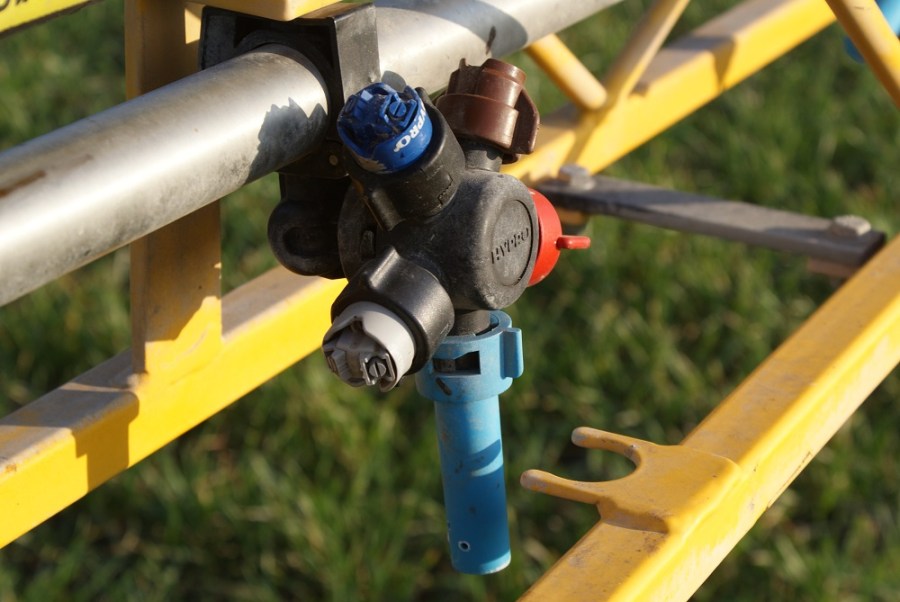With timing and application accuracy key to successful spraying, what can advances in sprayer and nozzle technology offer? CPM gets expert advice and summarises some options.
Variable-rate liquid applications are going to take off.
By Jane Brooks
Independent applications specialist Tom Robinson is clear on where he thinks sprayer developments are heading. “Having been involved in the industry for a considerable amount of time, I believe variable-rate liquid applications are going to take off,” he says.
“It’s been a slow gestation period, but trials of variable-rate spraying have shown clear benefits. So I’d like to see variable-rate application being part and parcel of a machine’s capability.”
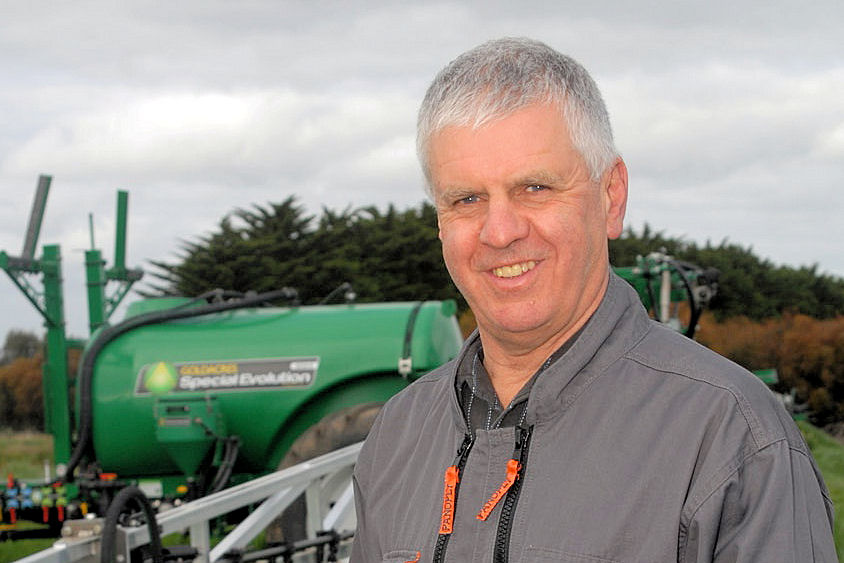
Tom Robinson says he would like to see variable-rate application being part and parcel of a machines capability.
He previously worked for Syngenta developing high performance and safe application techniques, such as the Defy and Amistar nozzles. Before leaving the company, he was involved in an industry-wide blackgrass project looking at patch spraying.
“Farmers don’t really like it because it’s binary, either on or off, and determining where the patches begin and end is a problem. Also there are weeds in the rest of the field, which if not sprayed can make the problem worse,” he explains.
“We tried a different approach – it’s common practice to apply two or three herbicides together in the autumn. We mapped the patches on a field and used different flow rates applying the full rate on the patches and a two-thirds dose everywhere else. This way the entire field gets sprayed, the patches receive slightly more and if you miss the beginning or end of the patch it has been treated anyway. It works really well but of course the crucial thing is having a sprayer that can handle different flow rates.”
What’s more, every chemical label recommends using a fanjet nozzle, he continues. “This is a real issue, because fanjets have become a poor way to spray and can always be bettered. So I totally empathise with people using other types of nozzle that aren’t recommended on the label.”
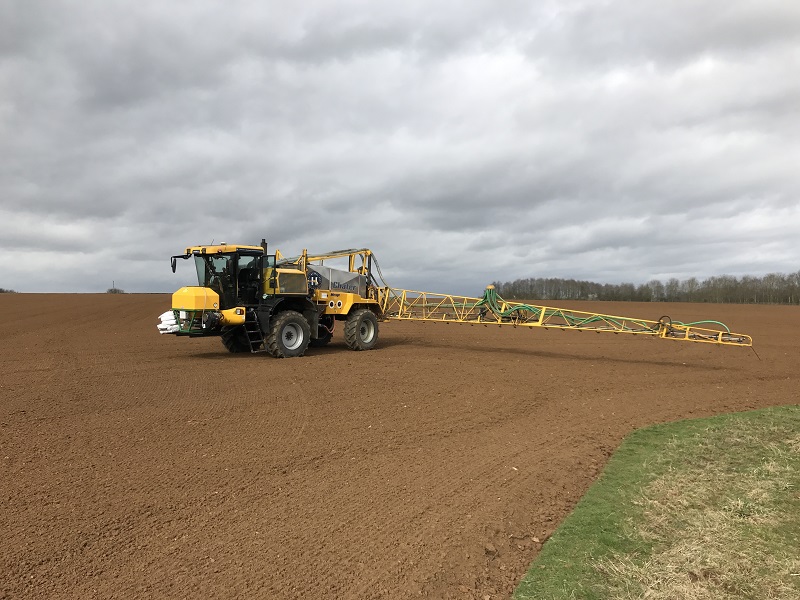
Will Hazell fuses a 24m Twin Air for both slug pellet and Avadex application
Having 50 nozzles to choose from isn’t helpful, he says. “I think farmers and operators need guidance about what does or doesn’t work. In my experience people who use Syngenta nozzles stick with them. This is because they’re specially designed for the job, do what the farmers want them to do, and this has been proven by all the research Syngenta has done.
“But they’re not on the label of a chemical container because Chemical Regulations Division (CRD) labelling hasn’t caught up with nozzle development, so we end up with the same method of application that was first on the label 40 years ago.”
In recent years, a whole raft of new regulations have come into force, and Tom Robinson also believes that operators should take the time to learn and understand the new Local Environment Risk Assessment for Pesticides (LERAP) recommendations.
Last year Amazone introduced its electric individual nozzle-control systems AmaSwitch and AmaSelect. Operated via the manufacturer’s GPS-Switch headland and part-width section control, both systems allow automatic individual nozzle switching with 50cm part-width sections.
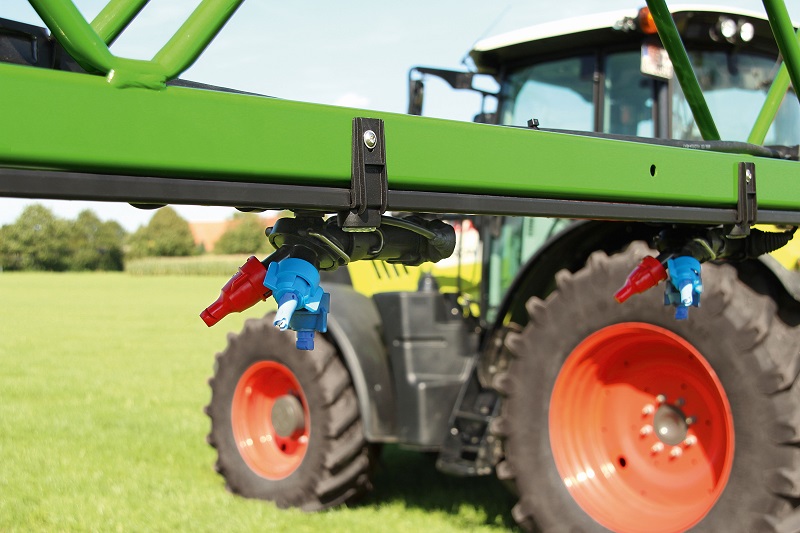
Amazone’s AmaSwitch system is for those who don’t need the remotely controlled electric switch-over but still want to have 50cm part-width sections.
Amazone says this results in even more precision in wedge-shaped areas, short work and on the headland – the amount of overlap is significantly reduced on the headland, for instance, by up to 85%. The AmaSwitch system is available for UF mounted sprayers as well as the UX trailed and Pantera self-propelled. It offers a favourably priced alternative to those who don’t need the remotely controlled electric switch-over between nozzle sizes, but who still want to have 50cm part-width sections.
AmaSelect electric individual nozzle switching consists of a four-way quad nozzle carrier with electric switch-over as well as on/off switching. So, the system also offers electric switch-over between the nozzles on each carrier via the in-cab operator terminal.
An optional 25cm nozzle-spacing extension kit is also available for AmaSelect nozzle carriers. In conjunction with special 80° nozzles, boom height can be reduced below 50 cm which should cut down on drift.
The Techneat Avacast Twin Air machine can be fitted directly to a sprayer utilising the boom to accurately apply granules up to 36m. The machine has a 400-litre hopper, high output fan and two metering units that feed a turnable distribution head on each boom side.
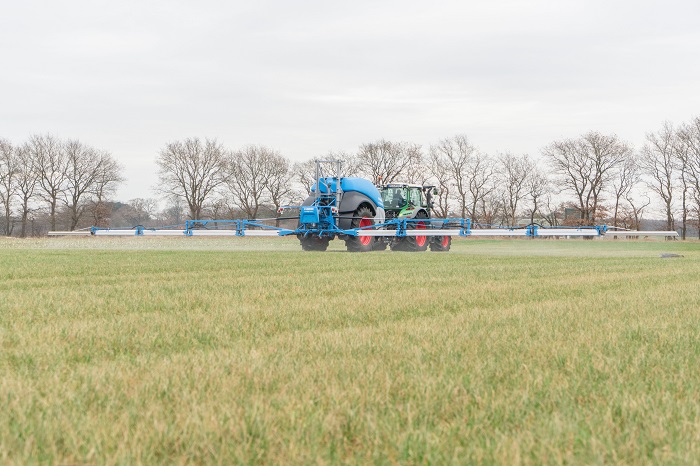
The Lemken Vega trailed sprayer is now available in boom lengths of up to 30m.
This allows for half-width shut-off for accurate headland control. The application rate is monitored and adjusted automatically by a Garmin GPS sensor linked to independent in-cab consoles. Headland shut-off is also controlled from the cab. The machine is also supplied with slug pellet cartridges giving very accurate placement at 500mm spacing across the boom.
Will Hazell from Hazell Agricultural Services Ltd, based in Oxon, uses a 24m Twin Air for both slug pellet and Avadex application. The unit is mounted on a self-propelled 2004 Chafer Mirage sprayer. “We took delivery in Aug and up until now I’d say we’ve probably done 1000ha. The main reason I went for the Techneat Twin Air is because it has 500mm spacing so you can apply the product a lot more precisely. I can also apply slug pellets and pre-emergence spray at the same time,” he says.
“I also use the Twin Air on the Chafer for contract spreading of Avadex, but find a lot of customers have already done their pre-emergence spraying, so we come in and just apply the Avadex (tri-allate). If it was done at the same time as spraying you would have to make sure the Avadex wasn’t getting wet with the spray as it was coming out of the boom.
“We find it’s very light and feels as if we’re basically running with an empty sprayer. The unit is mounted out in front of the sprayer; there are two outlet pipes that run to where the booms are on the rear. We set the pressure at about 5bar and that blows it down to the ends quite adequately. The metering units and distribution heads ensure that the same amount of product is delivered along the length of the boom for even spreading.”
Last year Lemken increased the boom lengths of their Vega trailed sprayer up to 30m, now giving a choice of boom sizes from15m. This is the first trailed sprayer designed internally by the Alpen agricultural machinery specialist and their Eltec system allows individual nozzle control in combination with the GPS-guided SectionControl system.
The Eltec electronic single-nozzle control allows all nozzles to be allocated to up to 13 part-width sections. The number of nozzles per part width section can be freely configured and saved in various profiles. The nozzles are controlled electrically directly at the nozzle holder. In the Eltec Pro version, all nozzles are controlled individually via electrical switches. This minimises any overlap during the last pass or when spraying angled field sections. A three-way nozzle body is standard, while a five-way nozzle body is available as an option.
Tank sizes include 3000, 4000 and 5000-litre options and it has an electronic control system operated through a remote-control unit above the induction tank, or Lemken’s MegaSpray menu on the in-cab terminal.
Lemken says stability is improved by a low centre of gravity, together with the positioning of the clean-water tank in the fenders. What’s more, the machine features a flat belly for better crop clearance, coil springs to give constant dampening of the booms and optional hydraulic drawbar suspension and steering options. Minimum boom height is 35cm up to 3m right under the nozzle, which is ideal for taller crops, such as sunflowers.
Knight Farm Machinery introduced its new individual-nozzle switching system at this year’s LAMMA Show. The nozzle shut-off system operates through Knight’s Sprayer-Controller, a communication module and Muller EDS modules. It offers GPS-controlled switching of individual spray nozzles for maximum efficiency with virtually no overlap or GPS automatic section switching.
Knight says that accurate nozzle switching prevents missed areas and minimizes overlap, thereby improving efficiency and preventing lodging. Prescription map, variable-rate control can also be achieved with multiple nozzle selection.
New sprayer steps into self-propelled market
With orders now being taken for its new Interceptor Self-propelled sprayer, Lincs-based sprayer manufacturer Chafer held a press day near to their Upton base at the end of March.
The introduction of the Interceptor marks Chafer’s return to the self-propelled sprayer market after a few years absence. “Chafer has around 22.5% of the larger trailed sprayer market and around 10% of the smaller trailed market,” says the company’s managing director Rob Starkey who went on to point out that although they have a significant market share the overall market for trailed sprayers is falling.
“The self-propelled market is twice the size of the trailed market – around 400 machines per annum – while with trailed machines it’s around the 170 mark, so the launch of the Interceptor is an important step for us.
“It strengthens our business by enabling us to supply a full product range to our target market – large arable farmers here in the UK. Also over the years we’ve supplied a significant number of machines to Australia, New Zealand, the Baltic States and Scandinavia and moving forward we believe there are significant opportunities for export sales.”
The Interceptor is aimed at the top end of British-built machines in terms of specification size, capacity and output but offers a lighter and more compact package than the larger European-built machines. The fully hydrostatic machine is designed in-house, as is the operating software. The company can custom build a machine based on operator requirements, which may be the best way to the variety of options on offer.
The Interceptor shares some significant features with Chafer’s latest range of trailed machines. These include the F and H-series booms, in widths from 24-36m, 4000 and 5000-litre steel tanks, similar plumbing and options such as section control, autosteer and ultrasonic boom-levelling.
It’s powered by a six-cylinder turbo charged Deutz Stage IV (tier V ready) AdBlue engine developing 215hp. The engine uses selective catalytic reduction and a particle filter to ensure it meets the emissions standards. Bosch Rexroth Hydro (CVT) transmission with built-in traction control and auto hill climb/descent automatically controls engine revs, keeping them low in normal conditions and increasing them when needed, minimizing fuel use.
The automatic throttle-less system is joystick controlled in both field or road mode. Additionally, there’s gyroscopic sensing when the sprayer is turning – acting similarly to a diff, the inner wheels slow down and the outer ones speed up slightly.
The engine is mounted behind the cab over the front axle and the boom is above the rear axle, which should provide pretty even weight distribution throughout the spraying process. The steel tank has been designed to maintain a low centre of gravity and it drains to the centre.
Options are manual, rotary-valve spraying control or Chafer’s latest ‘e’ plumbing system, which is controlled via two terminals – one in the cab and the other by the filling station.
It can be fitted with Topcon’s latest in-cab X35 touchscreen display console, an all-in-one system with full ISOBUS Universal Terminal (UT) and ISO Task Controller. It’s also designed to allow full data management capability through cloud-based technology.
It runs Topcon Horizon software and Horizon XTEND is also available to run applications via mobile devices such as tablets and smartphones.
Additionally, Remote support allows technicians to diagnose issues remotely. Multiple camera control is also available. The system includes ISO section control.
On the boom, a nozzle spacing of 50cm is standard, with triple nozzle bodies fitted with a set of three Hypro spray nozzles. Quin, Hypro Duo React or Altec Multispray nozzle bodies are options.
The Hypro centrifugal pump delivers up to 500 l/min and a max pressure of 10 bar. Variable-rate spraying is available on the machine, making it suitable for both fertiliser and crop-protection applications. Longer drop legs are an option, which will enable the machine to run on taller rims.
The large, pressurised cab on the prototype and display model is built by Fritzmeier. However, future production models will be equipped with a similar-style New Holland cab. Looking at a 36m boom Interceptor, prices start from £165,800 for a basic machine up to around £230,000 for a fully loaded model with just about every single option imaginable.
A smaller brother to the Interceptor will also be following shortly, called the Defender, it will be powered by the same Deutz engine, but rated at 180hp. Tank sizes of 3000 and 3500 litres and 24-30m boom widths will be available.

